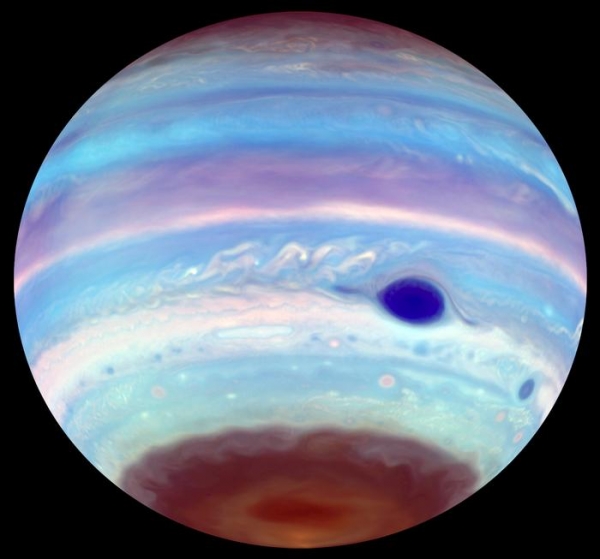Unusual magnetically driven vortices may be generating Earth-size concentrations of hydrocarbon haze.
While Jupiter’s Great Red Spot has been a constant feature of the planet for centuries, University of California, Berkeley, astronomers have discovered equally large spots at the planet’s north and south poles that appear and disappear seemingly at random.
The Earth-size ovals, which are visible only at ultraviolet wavelengths, are embedded in layers of stratospheric haze that cap the planet’s poles. The dark ovals, when seen, are almost always located just below the bright auroral zones at each pole, which are akin to Earth’s northern and southern lights. The spots absorb more UV than the surrounding area, making them appear dark on images from NASA’s Hubble Space Telescope. In yearly images of the planet taken by Hubble between 2015 and 2022, a dark UV oval appears 75% of the time at the south pole, while dark ovals appear in only one of eight images taken of the north pole.
The dark UV ovals hint at unusual processes taking place in Jupiter’s strong magnetic field that propagate down to the poles and deep into the atmosphere, far deeper than the magnetic processes that produce the auroras on Earth.
The UC Berkeley researchers and their colleagues reported the phenomena today (Nov. 26) in the journal Nature Astronomy.
Read more at University of California - Berkeley
Image: An artificially colored view of Jupiter as seen in ultraviolet light. In addition to the Great Red Spot, which appears blue, another oval feature can be seen in the brown haze at Jupiter's south pole. The oval, an area of concentrated haze, is possibly the result of mixing generated by a vortex higher up in the planet's ionosphere. These dark UV ovals also appear periodically at the north pole, though less often. (Credit: Troy Tsubota and Michael Wong, UC Berkeley)
Sci/Tech Top Stories
